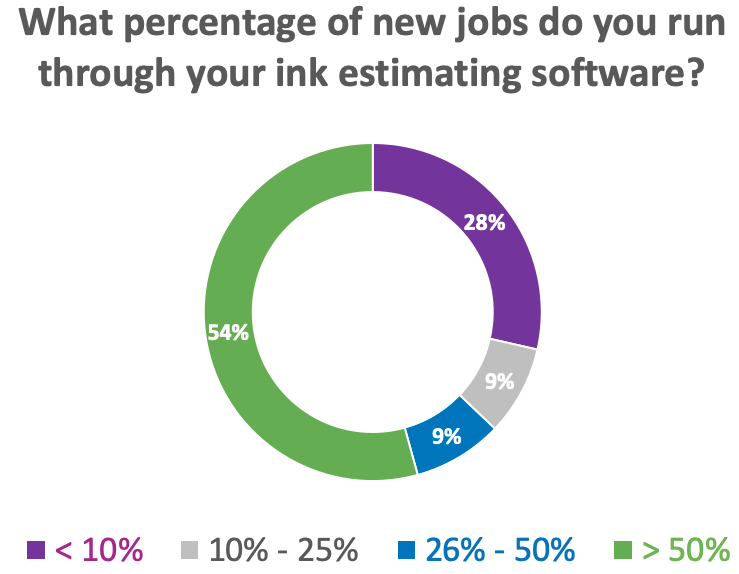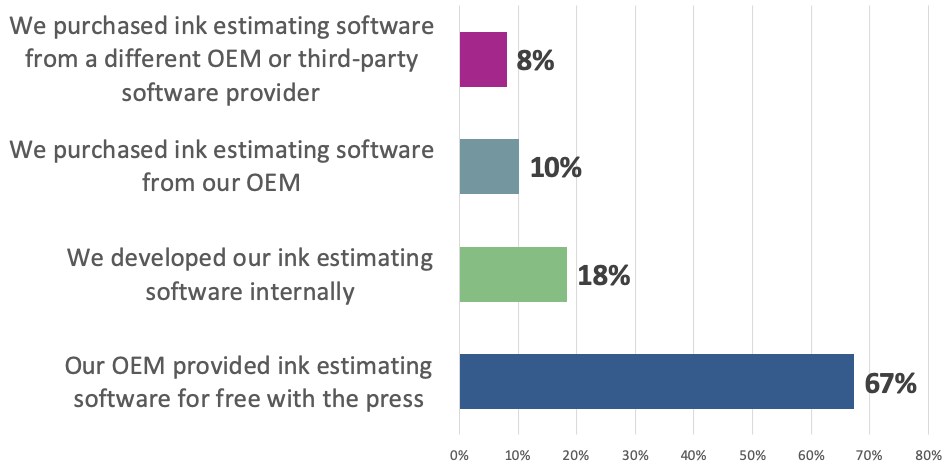Editor’s note: Alexandra Pekar also contributed to this article
Estimating in any print business can be a challenge, but inkjet users face a level of variability that users of other print technology don’t. Ink costs represent a large percentage of job costs and the level of ink use varies widely. Any time you change the media for a job, you also change the level of ink consumption – sometimes by a little but often by a lot. Savvy inkjet users also have the ability to control costs by limiting ink usage according to the minimum needed to hit particular color targets. This makes understanding ink costs on each job an important part of the estimating process.
In January we published the Production Inkjet Market Survey of Ink Estimating Solutions. We learned quite a bit from that research. First, 79% of respondents considered the ink estimating process to be important or very important to their overall estimating process. More than half (54%) of respondents indicated that they run more than half of new jobs through their estimating software and 81% indicated that there were particular types of jobs where ink estimating has helped them compete more effectively. However, not everyone follows best practices with ink estimating. More than a quarter (28%) of respondents indicated that they perform ink estimating on fewer than 10% of jobs. We dug further to find the reasons why.
Figure 1. Use of Ink Estimating Software

Source: Inkjet Insight Production Inkjet Market Survey on Ink Estimating
Survey responses included participants who reported working with a wide range of OEMs including Canon, Durst, EFI, Fujifilm, HP, Kodak, Konica Minolta, Kyocera, MCS, Monotech, Ricoh, RISO, Screen, Xerox and others. Many participants had presses from more than one inkjet OEM and some used more than one ink estimating tool. The survey also represented companies across application segments including direct mail, commercial marketing collateral, transaction print, books, catalogs, magazines, signage and display, packaging, labels, and newspapers. The majority of respondents used inkjet for more than one type of work.
Challenges with Estimating
There are multiple reasons for the discrepancy between the stated importance of ink estimating and the percentage of jobs actually estimated:
- Some companies don’t have an ink estimating solution installed, or the solution they have is linked to the press and can’t be used when a job is running.
- Some companies cite challenges with the ink estimating process, lack of time or lack of trained resources as reasons for not using their ink estimator.
- Transaction printing operations and those producing certain types of books have jobs that are relatively uniform in their formats and coverages. In these segments it is reasonable to create an estimating baseline using a representative sample of jobs (10% or fewer.)
- Other companies have extremely variable ink and paper usage and would prefer to run ink estimating, but they don’t receive a file to use for estimating prior to delivering a quote.
To generate a useful ink estimate, you need to have a production-ready PDF not just a designer’s concept file. It’s important to pre-flight the PDF for estimating the same way you would for production. For example, if black is specified as CMYK (rich black) instead of pure K you will lay down more ink than needed.
Once you have a tuned-up PDF, you need to make sure that you are setting the estimator to real-world conditions as well. Have you created a profile that limits inks? Will you be using primer? Will you run the file at full speed with a lower resolution? This may seem obvious, but I’ve seen many examples where companies estimate at full speed and end up producing a job at lower speed with the highest resolution to improve quality. However, that level of quality uses more ink and more press time, so it should be priced accordingly. If these scenarios exist in your shop, that means that the person doing the ink estimating needs to have the skill level to adjust for those settings and assumptions.
There can also be challenges with accuracy, particularly if you don’t look closely at what is being measured. OEMs take different approaches to their estimating process in a number of areas. First, the volume used to calculate the job. Some will measure based on 100 or 1,000 copies of the file and average the ink usage per page. Roll-fed estimates may be based on linear feet with the volume then averaged per image. In addition, some estimators measure the amount of precoat when used, while others don’t, or don’t show it clearly.
Another factor is the amount of ink used independent of image rendering for exercising printheads or flushing. Most importantly, remember that ink estimating is just that – an estimate. Several tools promise estimates with accuracy within +/- 5% while others might have a higher variation of 10% or more. Typically, the estimates are conservative to prevent customers from under estimating and losing money. However, how closely you set the parameters in the estimator to the reality of production will affect accuracy. If you own an ink estimating solution, take the time to check the accuracy of your estimator against your specific press and paper types.
Overcoming Challenges
Most inkjet printing system manufacturers provide an ink cost estimator to help printers determine an accurate cost per page. The majority of survey respondents (67%) owned software provided for free by their OEM and another 10% paid for software from their OEM. Another 18% developed a solution internally and some companies had access to more than one solution.
Figure 2. What Ink Estimating Software is Available for Your Use?

Source: Inkjet Insight Production Inkjet Market Survey on Ink Estimating
As noted earlier, if you don’t have files to run through it, even a perfectly accurate estimator won’t help. This is where work arounds come into play.
Data Reproductions Corporation in Auburn Hills, Michigan is a book and catalog producer who recognizes the importance of ink estimating. According to Dennis Kavanagh, DRC’s EVP and Chief Operating Officer, ink costs can run from 15% of the job cost for black only jobs up to 50% of the job cost for heavy coverage, high-color jobs. Unfortunately, they rarely receive files to estimate in advance of quoting, so they created their own process by drawing on data from actual runs. Daily ink consumption by job and by page is harvested from their inkjet press and put into a Microsoft Access database/MIS. From this data, they developed conservative estimate ranges for 3 classifications of jobs: mono, light/low-color and heavy/high-color. They also back-test jobs after production to verify that their estimates were in the target range of actuals. Kavanagh reported that between 2019 and 2020 fewer than 10 jobs out of 700 were costed incorrectly.
“We don’t constantly look at the ink usage now because of the fact that our methodology appears to work sufficiently,” said Kavanagh. “We have the luxury of having relatively simple requirements based on our niche as a book manufacturer.” This data drives a self-developed Excel-based estimator that is used by sales reps and estimating staff.
DRC is not alone, even companies who have commercial estimating solutions often need to find work-arounds. Martin Aalsma, Chief Operating Officer with AM Solutions, a customer-driven, multi-channel communications provider in Edgerton, WI reported that both a lack of files from customers and challenges with their OEM provided estimating tool have forced them into a 3-tier estimating process for much of their business.
Aalsma said, “Our press has an onboard estimator but you have to stop the machine from printing or RIPing anything to do the estimate, then drop the results into a homemade Excel sheet to calculate rough cost yourself. Besides the inefficiency of the process, the variance with that estimate and the final press report after printing was sometimes in excess of 5%, or even a 10% difference.”
Like DRC, AM Solutions uses data-driven work arounds that involve measuring actual usage from jobs and creating baselines for estimating future work. This is less than optimal for the company because their work is highly variable. To safe-guard their profit margins, they follow best-practices with qualifying and profiling their media, including developing different profiles for varying color requirements to ensure that they are using the minimum ink necessary to deliver a quality result.
“A lot of shops are not taking advantage of really fingerprinting their stock library to maximize ink savings to best quality,” noted Aalsma, “At one of the previous companies I worked at during the early days of inkjet, we had a consultant spend several days with us to optimize our color profiles to and teach us how to manage the ink. We saved about 20% on our ink costs.“
With or without estimating software, work-arounds are often needed to make sure that jobs are estimated profitably. If you don’t have estimating software, or don’t receive files to use with the system you have, create baselines using actual ink usage for typical jobs and generate guidelines for incorporating ink costs into the estimating process. It won’t be exact, but it will be as consistent and evidence-based as possible. Continuing the process by measuring actual job costs against estimates will help to refine guidelines over time.
Make it a regular practice to compare a wide sample of actual jobs produced to their related estimates. You will likely find that the estimator diverges from actuals in certain areas by a consistent amount and you can factor this into the estimating process. Also, consider that there are areas that the estimator will not catch on an individual job basis, such as time and ink usage on certain devices to ramp-up to printing speed. Make sure to also account for differences by paper type and by profile if you have multiple profiles per paper.
With estimating, you get out of it what you put into it, so take the time to set standards, estimate with multiple profile settings and compare against actual production to capture not only the ink usage per job and per page but the fluid usage for nozzle flushes/purges, spitting, and precoat.
If you are evaluating inkjet, consider your ink estimating options as carefully as you consider your press. Evaluate ink estimating solutions in parallel and see which software provides estimates that are closest to actuals as you run test jobs. If you already have inkjet, don’t be locked into the solution you have. Periodically consider how your estimating process can be improved and the costs and benefits of making a change. Keep in mind that as presses improve their resolution and media compatibility, software needs to keep up.
Read more of the Production Inkjet Market Survey on Ink Estimating Solutions, including customer satisfaction with their estimating solutions, usage by application segment and recommendations for inkjet users and OEMs.

